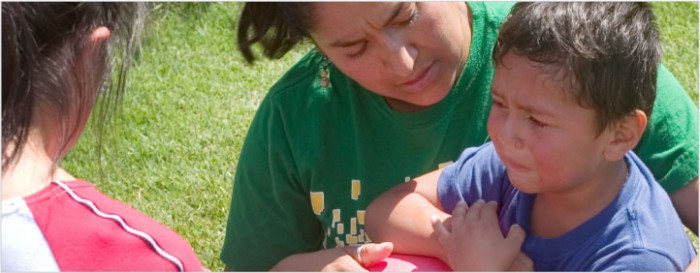Children thrive on connection with their parents.
Their need for a sense of connection is strong and constant through childhood. It is this sense of safety and connection that allows children to learn at a great rate, to experiment and play so fully, to enjoy themselves and others without reservation, and to trust in the goodness of the people they know.
A child's sense of connection and safety is easily broken
With infants and young children, a parent turning away to wash his hands or do the dishes is sometimes enough to break a child's sense that all is well. Because of this fragility, sooner or later, every child experiences some sad feelings about separation.
When a child feels upset by separation, there are two kinds of causes.
The break in connection is happening now. For instance, a parent goes to work, or must leave on a trip. A small hint of separation kicks up stored feelings. Putting a child to bed, going to another room, talking on the phone, or being rushed and overworked can open the floodgates to anxiety or grief that comes from earlier, more difficult separations.
Unresolved fears about separation are often at the root of difficult behaviors.
When a child is loaded with feelings about separation, but doesn't get a chance to express them, he can't sense that he's safe. He can't think. He signals that he is “off track” when he:
- Bites, hurts, or is forcefully “affectionate” with others.
- Withdraws from others or excludes others in their play.
- Wanders from one activity to another without paying attention to what he is doing.
- Whines or balks or is picky, or needs a special object to keep him from feeling upset.
You can help a child work through his feelings about separation
Children need to cry fully and feel frightened about a separation that is about to happen, or has already happened. While they cry, they need the love and caring of someone who offers them warmth and safety. At first, it seems like the oddest idea—why on earth would you let a child cry hard for his Mommy or Daddy, when you could distract him or put him to sleep or jiggle him or pat him until he stopped?
But over and over again, in thousands of situations, we have seen that children whose feelings are listened to become more confident, feel closer to their parents, and feel closer to the people who listened while they cried.
So here are the steps you can take to help a child actually heal the feelings he has about separation.
As you take these steps, he'll develop his ability to explore his world and take advantage of the friendships he is offered. He'll also retain his trust in those closest to him.
Connect well.
Children need to feel close to someone before they feel safe enough to release their feelings. So the first step in helping a child with separation is to add more warmth and connection around the time when good-by must be said. A period of parent-child or caregiver-child Special Time that includes warmth, eye contact, and laughter will help strengthen the child's sense of connection.
Initiate the separation
Then allow a long, tearful good-bye. Offer your warmth and support as the child cries, trembles, and struggles. This process of showing feelings fully with someone who will listen is natural, healthy, and deeply beneficial to the child. The longer the parent stays, the safer it will be for the child to show the feelings of desperation he or she has. The parent can do this listening, or the caregiver, or both. In any case, these are the steps to follow:
Stay close, but not too close. You want the child to feel your support, but also to feel the separation he is afraid of. Offer him eye contact and affection. If he burrows into you and stops crying, move him gently so that he can see you. Your attention will help him feel the grief again.
Listen to his tears and fears until he's finished, if you can. This is the fastest way for children to regain their confidence that all is well. For children who have big anxieties, crying with a safe person for thirty to sixty minutes at first is common. Repeated cries over several days or weeks may be necessary to relieve all of the child's fears.
Show confidence. If you are the parent, tell him, Grandma (or the sitter, or childcare provider) will take good care of you. I'll be back. I’ll always come back to you. If you are the childcare provider, tell him I'll watch over you until your Daddy comes back. When you feel better, we can play.
Allow repeated good-byes. Let the parent linger, saying, “It's time for me to go now.” This allows the child to keep showing you how sad or desperate he feels. His feelings are being shed in the safest possible context—with the parent nearby.
Bring the caregiver close. Say, “You're going to stay with Nana for awhile. Here she is. She'll take good care of you.” The child won't want to look at or touch the caregiver as he cries. The caregiver needs to know that the child isn't rejecting him or her personally. After a good cry, he'll be much more open to having fun with her.
Don't belittle the child or his feelings. His instinct to heal is at work. It's smart of him to build his confidence by unloading his fears. At some other time when your child isn't present, find someone to listen to your feelings. What do you feel when your child is showing deep feelings? What part of your childhood does it remind you of? What were you afraid of as a child? A listener will help you sort out your own feelings about separation, so that your own fears grow smaller, and you can offer your child more reassurance that all is well.
When you can't listen through a long good-bye
If a child has repeated upsets over separation, but you or your caregiver aren't set up to listen to him cry at length at drop-off time, you have three basic options:
After a few moments of good-bye, leave. Let him keep crying in the arms of a supportive caregiver. With support and information, caregivers can sometimes give the child five or ten minutes of listening time or more, before moving him on to another activity. However, there are times when the good of the group demands that a caregiver spread his or her attention more widely. So don't expect the caregiver to do all the listening work your child might need.
Begin the good-bye before you get there. Listen to your child cry before leaving home, before you get him out of the car, or outside the door at the caregiver's home or day care. This helps him get his emotional work done without placing what may be unworkable expectations on his caregiver.
Listen to your child's feelings at home. Children with feelings about separation often bring them up at a bedtime, when you go into another room, or when you pay attention to someone else. You can gently, gradually insist on small separations in these situations, listening as long as your child needs to cry. These at-home cries will help improve his confidence when being left in the care of others. If you have a partner, enlist your partner to listen to your child while he cries about missing you. It will improve their relationship, and help your child feel more confident in general.
We are sure that, although it may take repeated investments of time spent listening; you will see marked improvement in your child's confidence, his mood, and his ability to play with and trust others, as you listen to his feelings about separation.
Does your child need help with separation anxiety? We've put together our best thinking in the new online video class, “Say Good-bye to Separation Anxiety.”

